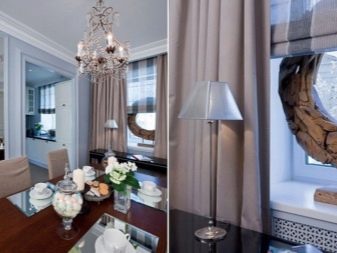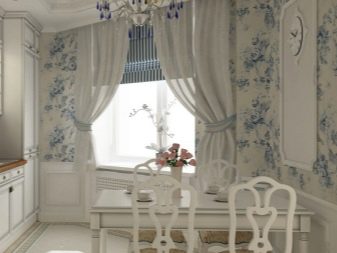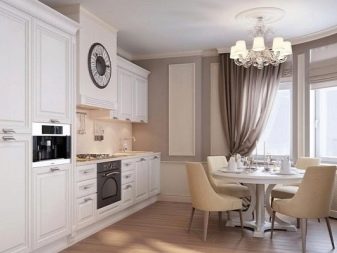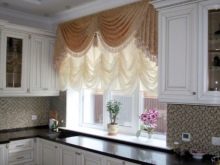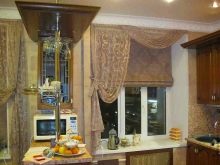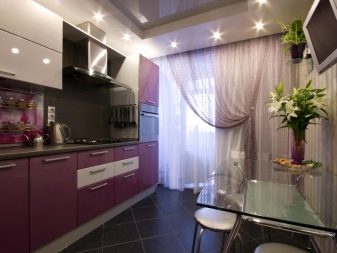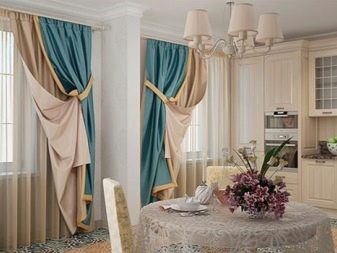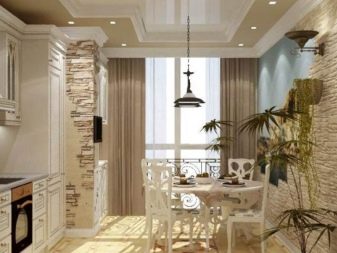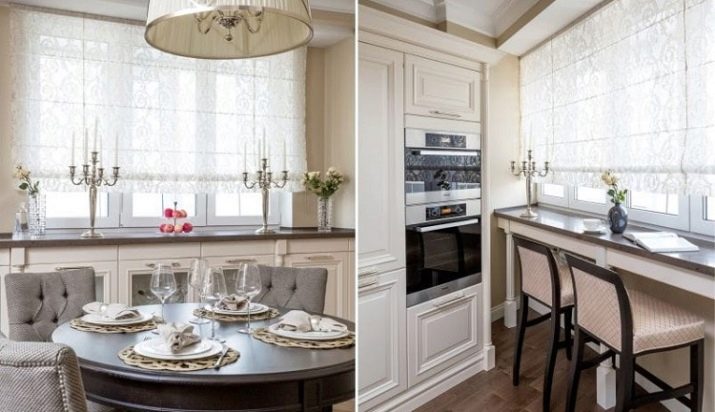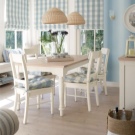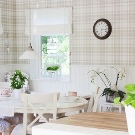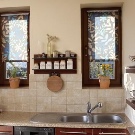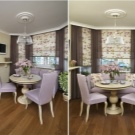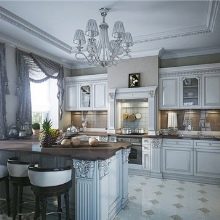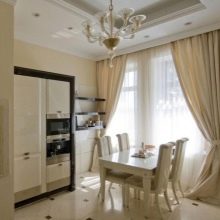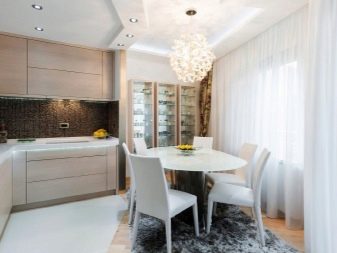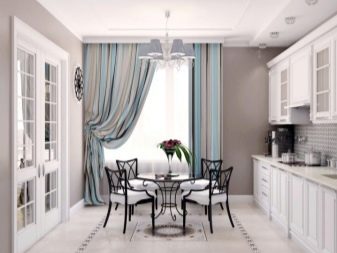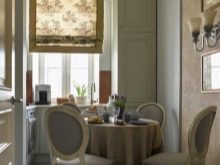Tips for choosing curtains in the living room-kitchen
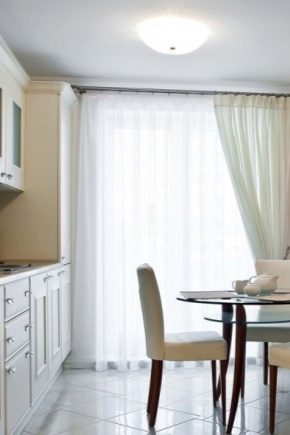
Curtains can make any room cozy, and often are one of the main elements of interior design. When choosing curtains in the combined kitchen-living room, you should take into account the fact that it is not always possible to choose the same curtains for two windows.
Requirements
It should be noted that the kitchen is the part of the apartment where the conditions are most destructive for the finishing and curtains, therefore in the connected kitchen-living room the main requirements for curtains are made based on the kitchen conditions. For example, here is a technique that heats up to very significant temperatures, and may have an open fire - this, of course, is about the stove.
Such equipment is often located in close proximity to the window.and since non-combustible textiles have not yet been invented, the only solution is to opt for short curtains that simply do not reach the fire, and even with a margin. Moreover, with strong heat the curtain may melt.
The fact that typical kitchen contaminations in the form of splashes of grease and other food traces, soot, and even odors well accumulate on the curtains does not contribute to the choice of long curtains. A typical portiere for a kitchen should be easy to clean, otherwise it will have to be thrown away pretty quickly due to a spoiled appearance.
The kitchen area is rarely truly spacious., because the curtains are usually designed to visually increase the space, or at least not contribute to the thickening of colors. For these purposes, it is advised to choose models of light tones, but without too bright hues, and small details are permissible, whereas large ones are undesirable.
For the living room or dining area, if such is allocated separately, the requirements are somewhat different. Here, more attention is paid to some chic - the room is designed to receive guests, and therefore should look presentable, demonstrating the success and good taste of the owners.
For local curtains, thoroughness is almost always characteristic - it is here that they are distinguished by a considerable length and are decorated with a large number of additional details like ruffs and fringes. Of course, a significant moment is also ease of use, because one of the tasks of window textiles is not just protection from excessive sunlight, but also the ability to regulate its quantity.
In addition, it is in the living room that there is usually access to a balcony, access to which should not be complicated. As for the appearance, there are practically no restrictions - the main thing is that the chosen curtain fits well with the surrounding style of the interior.
Design integrity
Modern designers argue that the demonstrative asymmetry of curtains in the kitchen-living room can be a plus for decorating a room, however, in the traditional sense of finishing a room, both windows should be draped in the same way. This means that you have to find curtains that are completely safe for the kitchen, and that they also meet the comfort requirements of a living room. If you do not want to go this route, please notethat commonality can be achieved due to the same color of window textiles, but otherwise, special attention should be paid to several types of curtains.
- Roll models are good because they are mounted directly on the frame, and therefore guaranteed not reach the fire and hot objects. They absolutely do not take up space, and allow you to use the sill useful, while they can look quite comfortable.
- Roman curtains They represent a model of the thoroughness that is so necessary for a cozy living room, but they are also suitable for the kitchen. The trick is that they can be raised and secured in this form, then with the same window textiles, the kitchen curtain will simply be much more ajar, without creating a fire hazard. Another thing is that they sew such an accessory more often from natural fabrics, and they absorb smells well.
- Tulle It is difficult to consider a full-fledged curtain, but if the windows do not face the sunny side or are constantly in the shade, something more substantial and unnecessary, otherwise in the kitchen-living room it will be constantly dark. Most likely, the difference will be in the length of the product, however, for the roll between the two zones it may be enough that the material is exactly the same.
In fact, there are much more options - you can use classic curtains, Japanese ones, and curtains on the grommets, but then in the process of planning and drawing up a design repair project you should think about how to make these traditionally long types of window textiles not dangerous in the kitchen part. If you want just long curtains, and even completely the same in both parts of the combined space, then the most sensible solution would be to think in advance how to remove all dangerous infrastructure away from the window.
If the stove and sink are quite far from the window, all that remains is to decide on a cloth that absorbs odors less and is easy to wash, and prepare for regular care of the curtains.
Material and color
Whatever one may say, for the kitchen part, curtains made of light fabrics will be much more practical - they absorb less dirt and odors, and it is even easier to maintain. This does not quite fit well with the choice for the living room, where they often prefer to hang something heavy, but the roll call between the two zones does not necessarily imply the full identity of window textiles - it can be the same color,but different in texture.
Another point in the choice of matter is its ability to protect from light and noise from the street. On average, the denser and thicker the curtain is, the better it copes with the task, but there are exceptions - some fabrics cope with this better than others, and some protect only from something alone. Before choosing a curtain, you should decide on what functional tasks it should perform.
The choice of color is somewhat more complicated, but an obligatory criterion is that, in combination with another environment, it must create a complete picture. This does not mean that the curtain should be the same color as the furniture or the walls - on the contrary, it can be radically different, being the main accent. On the other hand, with a room in the same tone, the curtains are usually somewhat distinguished - being the same color, it still differs from the same walls literally by a tone or two.
There is a third variant of interaction with the interior, when the curtain is made in exactly the same color as some furnishings, whereas in general the range of decoration and furniture consists of two or three different colors that are scattered around the room in a certain order, but combine well in a single unit.
It is believed that too dark curtains do not choose either the kitchen or the living room - they visually reduce the room and, as it were, put pressure on consciousness. Here it should be noted that this moment is still minor, because everything depends on the stylistic features of the design, and if the owner likes black textiles, then you can choose it, and light colors will add walls or furniture.
Separately, you need to say about the patterns or drawings. Large parts will necessarily reduce the room, and the abundance of small parts - on the contrary, will increase. Understanding this can be a good weapon in the hands of a person dissatisfied with the dimensions of his apartment.
Drawings and patterns, by the way, are able to influence not only the dimensions, but also the proportions - they are usually stretched in the plane that needs to be visually enlarged. Accordingly, the kitchen-living room with a too low ceiling is “drawn out” upward due to vertical lines or patterns, and horizontally oriented patterns will give it width.
How to choose the right color curtains, see the following video.
